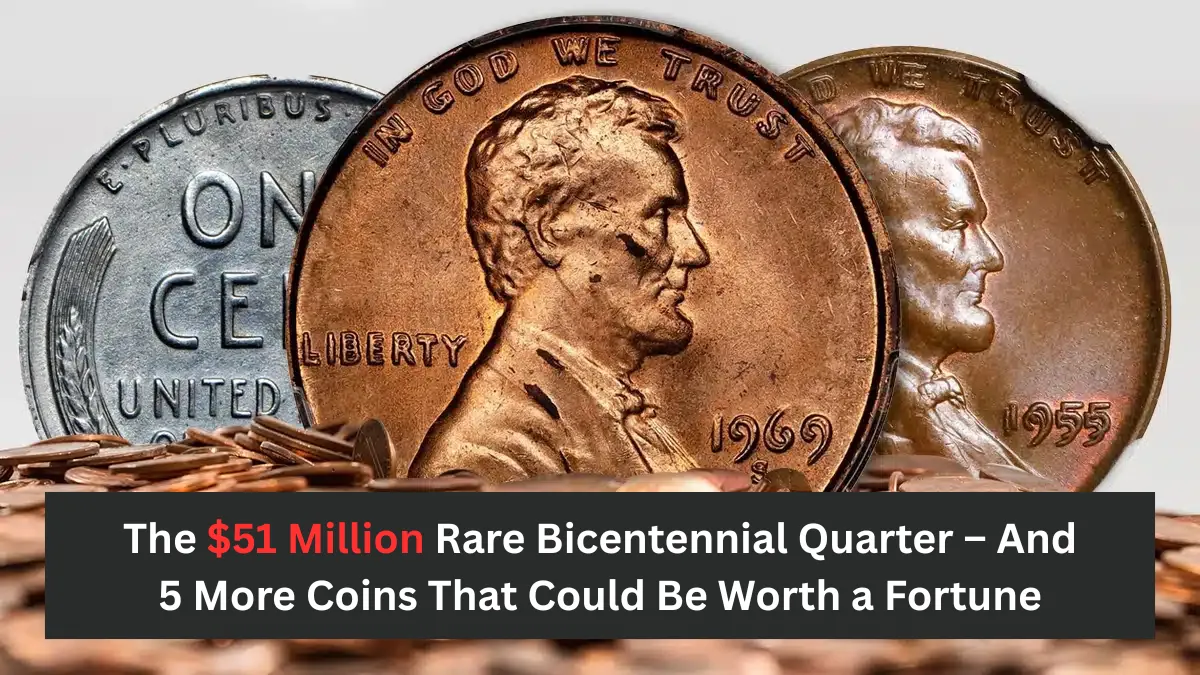What’s the Deal With the $51 Million Bicentennial Quarter?
In 1976, to honor two centuries of American freedom, the U.S. Mint released a special edition of the quarter known as the Bicentennial Quarter. Unlike the standard eagle reverse design, these coins feature a colonial drummer alongside the dates “1776–1976.” While the vast majority of these coins hold no more than their face value, a few rare variations—such as those composed of silver or struck with unique minting errors—have caught the eyes of collectors.
The quarter reportedly valued at $51 million is considered to possess a rare trifecta: a highly unusual minting error, exceptional preservation, and strong historical relevance. While no documented transaction has confirmed this valuation, many coin experts agree that if such a specimen were discovered, it could spark a competitive auction, potentially driving the price into the multi-million dollar range.
5 More Coins That Could Be Worth a Fortune
1. 1943 Copper Lincoln Penny – Up to $1.7 Million
In the midst of World War II, the U.S. Mint shifted to steel for penny production to conserve copper for the war effort. Despite this, a few 1943 pennies were mistakenly minted using copper blanks and circulated unknowingly. Today, these extremely rare coins are among the most coveted by collectors.
A simple test? Try using a magnet. If your 1943 penny doesn’t cling to it, you may be holding one of the ultra-rare copper versions.
2. 1913 Liberty Head Nickel – Over $4 Million
With only five known examples in existence, the 1913 Liberty Head Nickel is one of the rarest coins in U.S. history. These coins were never officially approved for production, which makes them especially intriguing to numismatists and investors alike.
One of these nickels fetched over $4.5 million at auction, reflecting its unmatched scarcity and appeal.
3. 1794 Flowing Hair Silver Dollar – Around $10 Million
This coin is widely believed to be the very first silver dollar ever struck by the United States Mint, making it a cornerstone piece of American numismatic history. Its rarity and foundational role in U.S. currency give it immense value and desirability among collectors.
The 1794 Flowing Hair Dollar not only embodies the beginnings of the American financial system but also remains a dream find for any serious collector.
4. 2007 “Godless” Presidential Dollar – Up to $3,000
In 2007, a number of George Washington $1 coins were accidentally released missing the inscription “IN GOD WE TRUST.” Dubbed the “Godless Dollars,” these error coins quickly gained attention from collectors due to the rarity of the printing mistake.
Though not in the million-dollar range, a well-preserved example can still command a few thousand dollars, depending on its condition and market demand.
5. 1982 No Mint Mark Roosevelt Dime – Up to $300,000
Dimes typically carry a small letter indicating which mint produced them. However, a limited batch of 1982 Roosevelt dimes from the Philadelphia Mint were mistakenly issued without any mint mark. This manufacturing error has made them highly sought-after among coin hunters.
If you spot a 1982 dime with no mint mark under the date, it’s worth having it evaluated—you might be sitting on a small fortune.
How to Spot a Valuable Coin
Think you might have a rare coin hiding in your change jar? Start by checking the year and look closely for a mint mark, usually located beneath the date on the front of the coin. Rare dates and missing or unusual mint marks are key indicators of value.
Errors are another red flag—watch for coins with double stamping, uneven alignment, or missing inscriptions. Use a magnet to help identify certain types, like the famous 1943 steel and copper penny mix-ups.
Also, don’t overlook the condition. Coins that are sharp in detail and free of wear are typically more valuable, especially to serious collectors.
Don’t Clean Rare Coins!
It might be tempting to polish an old or dirty coin, but doing so can actually harm its value. Cleaning can cause surface damage that reduces the coin’s grade and desirability. Instead, carefully store your find in a protective holder and consider having it professionally appraised by trusted grading companies like PCGS or NGC.
FAQs
1. Is there really a Bicentennial Quarter worth $51 million?
While there’s no confirmed $51 million sale, some rare Bicentennial Quarters with unique errors or conditions could reach sky-high values due to collector interest.
2. How do I know if my Bicentennial Quarter is valuable?
Look for silver composition, proof finishes, or minting errors. Coins in perfect condition, especially with unique traits, can be worth significantly more than 25 cents.
3. Where can I get my coins appraised?
You can use trusted grading services like PCGS (Professional Coin Grading Service) or NGC (Numismatic Guaranty Company) to verify and appraise your coins.
4. What’s the most valuable coin ever sold?
The 1794 Flowing Hair Silver Dollar holds the record, selling for around $10 million, making it one of the most valuable coins in history.
John M. Moody is a passionate writer known for his insightful and engaging storytelling. With a background in astrology and a love for exploring the human experience, John weaves cosmic wisdom into compelling narratives that inspire and enlighten. His work spans articles, essays, and spiritual guides, often blending mystical themes with real-life reflections. When he's not writing, John enjoys stargazing, reading mythology, and connecting with nature for creative inspiration.
